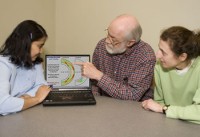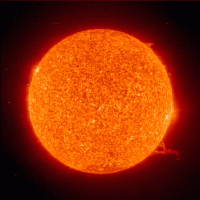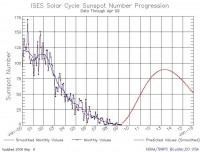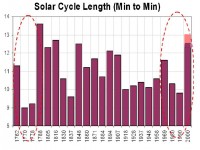Jun 01, 2009
Wayback Machine: Scientists Issue Unprecedented Forecast of Next Sunspot Cycle
By Anthony Watts, Watts Up with That
This is an official NCAR News Release (National Center for Atmospheric Research) Apparently, they have solar forecasting techniques down to a “science”, as boldly demonstrated in this press release. Anthony Watts
Scientists Issue Unprecedented Forecast of Next Sunspot Cycle
BOULDER - The next sunspot cycle will be 30-50% stronger than the last one and begin as much as a year late, according to a breakthrough forecast using a computer model of solar dynamics developed by scientists at the National Center for Atmospheric Research (NCAR). Predicting the Sun’s cycles accurately, years in advance, will help societies plan for active bouts of solar storms, which can slow satellite orbits, disrupt communications, and bring down power systems.
The scientists have confidence in the forecast because, in a series of test runs, the newly developed model simulated the strength of the past eight solar cycles with more than 98% accuracy. The forecasts are generated, in part, by tracking the subsurface movements of the sunspot remnants of the previous two solar cycles. The team is publishing its forecast in the current issue of Geophysical Research Letters.

NCAR scientists Mausumi Dikpati (left), Peter Gilman, and Giuliana de Toma examine results from a new computer model of solar dynamics. (Photo by Carlye Calvin, UCAR)
The Sun goes through approximately 11-year cycles, from peak storm activity to quiet and back again. Solar scientists have tracked them for some time without being able to predict their relative intensity or timing. “Our model has demonstrated the necessary skill to be used as a forecasting tool,” says NCAR scientist Mausumi Dikpati, the leader of the forecast team at NCAR’s High Altitude Observatory that also includes Peter Gilman and Giuliana de Toma. Forecasting the cycle may help society anticipate solar storms, which can disrupt communications and power systems and affect the orbits of satellites. The storms are linked to twisted magnetic fields in the Sun that suddenly snap and release tremendous amounts of energy. They tend to occur near dark regions of concentrated magnetic fields, known as sunspots.
The NCAR team’s computer model, known as the Predictive Flux-transport Dynamo Model, draws on research by NCAR scientists indicating that the evolution of sunspots is caused by a current of plasma, or electrified gas, that circulates between the Sun’s equator and its poles over a period of 17 to 22 years. This current acts like a conveyor belt of sunspots.
The sunspot process begins with tightly concentrated magnetic field lines in the solar convection zone (the outermost layer of the Sun’s interior). The field lines rise to the surface at low latitudes and form bipolar sunspots, which are regions of concentrated magnetic fields. When these sunspots decay, they imprint the moving plasma with a type of magnetic signature. As the plasma nears the poles, it sinks about 200,000 kilometers (124,000 miles) back into the convection zone and starts returning toward the equator at a speed of about one meter (three feet) per second or slower. The increasingly concentrated fields become stretched and twisted by the internal rotation of the Sun as they near the equator, gradually becoming less stable than the surrounding plasma. This eventually causes coiled-up magnetic field lines to rise up, tear through the Sun’s surface, and create new sunspots. The subsurface plasma flow used in the model has been verified with the relatively new technique of helioseismology, based on observations from both NSF- and NASA-supported instruments. This technique tracks sound waves reverberating inside the Sun to reveal details about the interior, much as a doctor might use an ultrasound to see inside a patient.
Predicting Cycles 24 and 25
The Predictive Flux-transport Dynamo Model is enabling NCAR scientists to predict that the next solar cycle, known as Cycle 24, will produce sunspots across an area slightly larger than 2.5% of the visible surface of the Sun. The scientists expect the cycle to begin in late 2007 or early 2008, which is about 6 to 12 months later than a cycle would normally start. Cycle 24 is likely to reach its peak about 2012.
By analyzing recent solar cycles, the scientists also hope to forecast sunspot activity two solar cycles, or 22 years, into the future. The NCAR team is planning in the next year to issue a forecast of Cycle 25, which will peak in the early 2020s. “This is a significant breakthrough with important applications, especially for satellite-dependent sectors of society,” explains NCAR scientist Peter Gilman.
The NCAR team received funding from the National Science Foundation and NASA’s Living with a Star program. The date of this NCAR News Release is March 6, 2006. See full story and the many comments here.
May 30, 2009
Larry Solomon: ENRON’S Other Secret
By Lawrence Solomon, The Financial Post
We all know that the financial stakes are enormous in the global warming debate - many oil, coal and power companies are at risk should carbon dioxide and other greenhouse gases get regulated in a manner that harms their bottom line. The potential losses of an Exxon or a Shell are chump change, however, compared to the fortunes to be made from those very same regulations.
Some of the climate-change profiteers are relatively unknown corporations; others are household names with only their behind-the-scenes role in the climate-change industry unknown. Over the next few weeks, in an extended newspaper series, you will become familiar with some of the profiteers, and with their machinations. This series begins with Enron, a pioneer in the climate-change industry.
Almost two decades before President Barack Obama made “cap-and-trade” for carbon dioxide emissions a household term, an obscure company called Enron - a natural-gas pipeline company that had become a big-time trader in energy commodities - had figured out how to make millions in a cap-and-trade program for sulphur dioxide emissions, thanks to changes in the U.S. government’s Clean Air Act. To the delight of shareholders, Enron’s stock price rose rapidly as it became the major trader in the U.S. government’s $20-billion a year emissions commodity market.
The climate-change industry - the scientists, lawyers, consultants, lobbyists and, most importantly, the multinationals that work behind the scenes to cash in on the riches at stake - has emerged as the world’s largest industry. Virtually every resident in the developed world feels the bite of this industry, often unknowingly, through the hidden surcharges on their food bills, their gas and electricity rates, their gasoline purchases, their automobiles, their garbage collection, their insurance, their computers purchases, their hotels, their purchases of just about every good and service, in fact, and finally, their taxes to governments at all levels.
These extractions do not happen by accident. Every penny that leaves the hands of consumers does so by design, the final step in elaborate and often brilliant orchestrations of public policy, all the more brilliant because the public, for the most part, does not know who is profiteering on climate change, or who is aiding and abetting the profiteers.
Enron Chairman Kenneth Lay, keen to engineer an encore, saw his opportunity when Bill Clinton and Al Gore were inaugurated as president and vice-president in 1993. To capitalize on Al Gore’s interest in global warming, Enron immediately embarked on a massive lobbying effort to develop a trading system for carbon dioxide, working both the Clinton administration and Congress. Political contributions and Enron-funded analyses flowed freely, all geared to demonstrating a looming global catastrophe if carbon dioxide emissions weren’t curbed. An Enron-funded study that dismissed the notion that calamity could come of global warming, meanwhile, was quietly buried.
To magnify the leverage of their political lobbying, Enron also worked the environmental groups. Between 1994 and 1996, the Enron Foundation donated $1-million to the Nature Conservancy and its Climate Change Project, a leading force for global warming reform, while Lay and other individuals associated with Enron donated $1.5-million to environmental groups seeking international controls on carbon dioxide.
The intense lobbying paid off. Lay became a member of president Clinton’s Council on Sustainable Development, as well as his friend and advisor. In the summer of 1997, prior to global warming meetings in Kyoto, Japan, Clinton sought Lay’s advice in White House discussions. The fruits of Enron’s efforts came soon after, with the signing of the Kyoto Protocol.
An internal Enron memo, sent from Kyoto by John Palmisano, a former Environmental Protection Agency regulator who had become Enron’s lead lobbyist as senior director for Environmental Policy and Compliance, describes the historic corporate achievement that was Kyoto.
“If implemented this agreement will do more to promote Enron’s business than will almost any other regulatory initiative outside of restructuring of the energy and natural-gas industries in Europe and the United States,” Polisano began. “The potential to add incremental gas sales, and additional demand for renewable technology is enormous.”
The memo, entitled “Implications of the Climate Change Agreement in Kyoto and What Transpired,” summarized the achievements that Enron had accomplished. “I do not think it is possible to overestimate the importance of this year in shaping every aspect of this agreement,” he wrote, citing three issues of specific importance to Enron which would become, as those following the climate-change debate in detail now know, the biggest money plays: the rules governing emissions trading, the rules governing transfers of emission reduction rights between countries, and the rules governing a gargantuan clean energy fund.
May 29, 2009
Bloomberg on Exxon Mobil: Energy and Climate Realists
By Joe Carroll, Bloomberg
Exxon Mobil Corp., the world’s largest refiner, said the transition away from oil-derived fuels is probably 100 years away.
Petroleum-based fuels including gasoline and diesel, as well as hydrocarbons such as coal and natural gas, will remain the dominant sources of energy for factories, offices, homes and cars for decades because there are no viable alternatives, Chief Executive Officer Rex Tillerson told reporters today after Exxon Mobil’s annual shareholders meeting in Dallas.
In the U.S., which burns a quarter of global oil supplies, consumers probably face higher fuel prices if lawmakers impose greenhouse-gas rules that inflate fuel-production costs, Tillerson said. A plan introduced by Democrats this month would allocate a limited number of emission credits to refiners and electricity producers, with the aim of curbing greenhouse gases.
“The oil-gas-refining side of the business received a very, very small amount of the allocations, which means that sector will bear more of the costs more immediately,” Tillerson said. “If we’re going to place a price on carbon, let’s do that in the most efficient way. A carbon tax is more efficient than a tax that’s applied by way of a cap-and-trade mechanism.”
Tillerson, 57, said lawmakers are hurrying to restrict greenhouse gases when many scientific questions surrounding the global warming issue remain unresolved.
“The point of conflict that I find more often than not are the projections that some make regarding how serious the problem may become and at what pace of acceleration it may occur,” Tillerson told investors at the shareholders meeting. “All of those models have deficiencies in the way they’re constructed and the assumptions that go into the models and the limitations of the data.”
Tillerson, a University of Texas-trained engineer, said climate change is a “serious risk-management issue” for Exxon Mobil. The company will continue to fund scientific research into climate science and the impact of greenhouse gases on the atmosphere, he said.
“We’re going to be very forthright in not accepting something that is not completely scientifically proven,” Tillerson said. “We’re not skeptics. We’re just approaching this the way we would approach any scientific challenge, and it’s a serious challenge.” Read more here.
May 28, 2009
New Solar Cycle Prediction: Fewer Sunspots, But Not Necessarily Less Activity
May 27th, 2009 By Tony Phillips
An international panel of experts has released a new prediction for the next solar cycle, stating that Solar Cycle 24 will peak in May 2013 with a below-average number of sunspots. Led by the National Oceanic and Atmospheric Administration (NOAA) and sponsored by NASA, the panel includes a dozen members from nine different government and academic institutions. Their forecast sets the stage for at least another year of mostly quiet conditions before solar activity resumes in earnest.

“If our prediction is correct, Solar Cycle 24 will have a peak sunspot number of 90, the lowest of any cycle since 1928 when Solar Cycle 16 peaked at 78,” says panel chairman Doug Biesecker of the NOAA Space Weather Prediction Center, Boulder, Colo.
It is tempting to describe such a cycle as “weak” or “mild,” but that could give the wrong impression. “Even a below-average cycle is capable of producing severe space weather,” says Biesecker. “The great geomagnetic storm of 1859, for instance, occurred during a solar cycle of about the same size we’re predicting for 2013.”

This plot of sunspot numbers shows the measured peak of the last solar cycle (Solar Cycle 23) in blue and the predicted peak of the next solar cycle (24) in red. Credit: NOAA/Space Weather Prediction Center.
The 1859 storm—named the “Carrington Event” after astronomer Richard Carrington who witnessed the instigating solar flare—electrified transmission cables, set fires in telegraph offices, and produced Northern Lights so bright that people could read newspapers by their red and green glow. A recent report by the National Academy of Sciences found that if a similar storm occurred today, it could cause $1 to 2 trillion in damages to society’s high-tech infrastructure and require four to ten years for complete recovery. For comparison, Hurricane Katrina caused $80 to 125 billion in damage.
The latest forecast revises a prediction issued in 2007, when a sharply divided panel believed solar minimum would come in March 2008 and would be followed by either a strong solar maximum in 2011 or a weak solar maximum in 2012. Competing models of the solar cycle produced different forecasts, and researchers were eager for the sun to reveal which was correct.
“It turns out that none of the models were really correct,” says Dean Pesnell of the Goddard Space Flight Center, Greenbelt, Md. NASA’s lead representative on the panel. “The sun is behaving in an unexpected and very interesting way.” Read story here.
Icecap Note: Other forecasters (Clilverd and Archibald) have an even quieter cycle like that of the s0-called Dalton Minimum with a maximum nearer 40. NCAR’s Dikpati is still holding out for an active cycle 24. The last few cycles including this ultralong cycle 23 (larger image here) mimics the cycles of the late 1700s and early 1800s much as Clilverd and Archibald showed, leading up to the Dalton Minimum, the age of Dickens with winter snows in London (hmmm).

May 26, 2009
No scientific “consensus” about “global warming”
By Bob Ferguson and Lord Christopher Monckton, SPPI
WASHINGTON--(BUSINESS WIRE)—The Science and Public Policy Institute (SPPI) in Washington reports that a leading expert on climate and former advisor to Margaret Thatcher as UK Prime Minister, has dismissed as false a recent claim by the Washington Post that “most scientists now say there is a consensus about climate change”; that warming is “unequivocal”; and that most of the warming of the past century was manmade.
Christopher Monckton, in a new paper for SPPI entitled Unequivocal ‘Consensus’ on ‘Global Warming’, says:
“There is ... no sound or scientific basis for the notion, peddled by the Washington Post, that there is a scientific ‘consensus’ to the effect that anthropogenic ‘global warming’ has occurred, is occurring, will occur, or, even if eventually it does occur, will be significant enough to be dangerous.”
The SPPI paper reveals the following facts that are usually overlooked or ignored -
>Science is not done by “consensus”: the argument from consensus is an instance of the Aristotelian logical fallacy known as the “head-count” fallacy.
>The decision by the UN’s climate panel to attribute more than half of the past 50 years’ warming to humankind was taken by an unscientific show of hands.
>The UN’s chapter attributing most of the past half century’s warming to humankind was rejected by most of the UN’s own official reviewers.
>The warming rate from 1975-1998, when humankind might have had some influence, was the same as the rate from 1860-1880 and from 1910-1940, when humankind’s influence was negligible.
>There is no anthropogenic signal at all in the global temperature record.
>For 15 years there has been no statistically-significant “global warming”.
>For 7.5 years there has been rapid but largely-unreported global cooling.
>The greatest warming rate in the past 300 years was from 1645 to 1715, before the Industrial Revolution began. That warming rate was eight times the 20th-century warming rate.
>The warming of the past 300 years is indeed unequivocal, but the mere fact of the warming tells us nothing of its cause. There is no scientific basis for attributing most of it to humankind.
>The notion that “2,500 scientists” personally agreed with the 2007 assessment report of the UN’s climate panel is nonsense.
>The largest-ever survey of scientific opinion - the largest to date - found more than 31,000 scientists did not consider the human contribution to “global warming” significant enough to be dangerous.
>Much of the UN’s reports are written by environmental campaigners, not scientists.
Robert Ferguson, SPPI’s president, said: “In a May 19 article by David Fahrenthold, yet again the Washington Post has been caught out publishing false science, selective data, and faulty conclusions. It is time that certain sections of the news media realized that, as every opinion poll shows, fewer and fewer of the public are any longer believing the politically-driven nonsense they write about ‘global warming’”.
Asks Ferguson, “Has the Washington Post resurrected former Post reporter Janet Cook? Instead of fabricating an 8-year-old heroin addict, has Fahrenthold fabricated a “consensus” about global warming science? Like Cook’s story, the Post’s report proves bereft of evidence and reality. On April 17, 1981, shortly after Cook and the Post were exposed, the New York Times editorialized, ‘When a reputable newspaper lies, it poisons the community; every newspaper story becomes suspect.’ We could not have said it better. Even more tragically, these climate fantasies put at risk the economies and liberties of the Western World and the lives of many in the Third World. Where is the accountability?” See story here.
|






